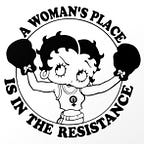Slapstick Divas: interview with author Steve Massa
Even the people who don’t like cinema very much — who are those? — are familiar with Charlie Chaplin’s face. Even those who like cinema but avoid silent movies have heard about Chaplin, Keaton and Lloyd. But you’ve got to be a die-hard silent film fan to know the women of silent comedy: Mabel Normand, Alice Howell, Gale Henry, Jane Bernoudy, Fay Tincher, Flora Finch… Many could say that no women became huge silent film clowns because you can’t be pretty and funny at the same time, but we all know this is bullshit: funny women of the silent screen are overlooked because the canon was established by and, until very recently, controlled by men. But it took one man to shine a light on the silent comedy female stars: with his mammoth book “Slapstick Divas”, Steve Massa created a complete, exhaustive and incredibly informative guide that all film fans can learn from.
Steve says that “Silent comedies, above all, are fun, so I think writings about them should be fun too.” He certainly succeeded in creating a fun guide about these funny ladies — and was also very kind to answer six questions we made:
Q: In which ways were those slapstick divas trailblazing?
A: They were trailblazing in that they focused on women’s problems and misadventures. In the very first slapstick comedies from Europe the female roles were often played by men, especially if it was going to contain a lot of roughhousing. At the time it was thought that women were too delicate, or it was too undignified, for them to participate in physical knockabout. Soon there arrived hardy actresses like Sarah Duhamel and Lea Giunchi who jumped right into the action.
In America, Mabel Normand was probably the first, but she was quickly followed by ladies such as Alice Howell, Gale Henry, Polly Moran, Marie Dressler and others. Although their films were comic and detailed their misadventures these were female characters who were in control — they weren’t content to sit back and just be domestic. To good or bad (comically bad that is) effect they took charge of themselves and created action.
Q: Categories (bathing beauty, romantic interest, comedienne, character actress) were molds hard to break. Was this as hard for men? What about the women who proved to be more versatile than what was expected? Was their career harmed by this?
A: The category situation was very similar for the men. For women as well as men the categories were dictated by their physical appearance — if they were tall, fat, skinny, attractive, or just plain funny looking, etc. Being physically “unusual” could hold a performer back from becoming a “star,” but there was some flexibility between the categories. For instance many of the women who started out as bathing beauties moved on to being romantic interests or leading ladies in more polite comedies. Examples of this are people like Phyllis Haver, Marie Prevost, Thelma Hill, Elinor Field, and others. If a woman was “too character” like Polly Moran or Dorothea Wolbert, they would often become supporting players in features. Same for the men.
Q: We often see wrong assumptions about silent comedy like “only men worked behind the camera doing slapstick” or “humor in slapstick consists of only slipping on banana peels.” Do you think that, by highlighting women who worked in front of and behind the cameras, a bigger number of young people can get interested in silent film?
A: I think young people are very pleasantly surprised to see the slapstick comediennes. The cliché is that it was only men, but that’s been proven wrong. The female comedians often have a different viewpoint and take on routines or situations than their male counterparts, and I think this creates a variety that helps to get young people more interested in the films.
Q: We often talk about the slapstick big four guys (Chaplin, Keaton, Lloyd, Langdon) — who would you choose as the slapstick big four girls?
A: Of course these are completely personal choices, but I would pick Mabel Normand, Alice Howell, Gale Henry, and Louise Fazenda. All were originals with unique performing styles, and were very influential on the other funny ladies.
During a seventeen-year career Mabel Normand was a comedienne, athlete, screen beauty, and film director. Both clown and leading lady, she was the acorn from which all the ensuing silent comediennes sprang. Alice Howell and Gale Henry were both part of comedy ensembles, and became so popular that they graduated to their own starring series. Louise Fazenda worked her way up from support at Joker Comedies to starring shorts for Mack Sennett. She moved on to starring in features for Warner Brothers, and after sound came in she was busy as a character actress until she retired in 1939.
Q: Funny women in the silent era came from vaudeville to the movies. Funny women now come from stand-up comedy to films and TV shows. Do you see similarities between these two ways from zero to stardom?
A: It’s absolutely the same — except the focus is more verbal comedy than physical slapstick. But that suits modern films. Another difference is volume and opportunity. In the early 20th Century the sheer number of films made was immense, and there were plenty of opportunities for all kinds of performers to break into films. So there were more funny ladies on the screen.
Q: What can women working in film today learn from the slapstick divas from over a century ago?
A: That there is a long and varied history of women in the film industry — not just performers, but writers, directors, editors, and designers. In some ways today’s industry is similar to the early days as there are more opportunities for women to make their mark.
